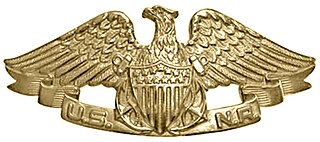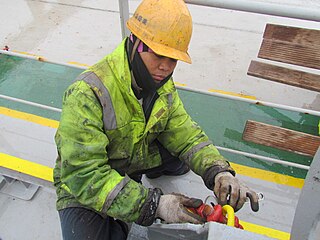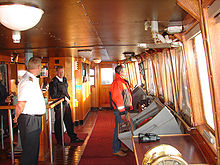
Maritime transport or more generally waterborne transport, is the transport of people (passengers) or goods (cargo) via waterways. Freight transport by sea has been widely used throughout recorded history. The advent of aviation has diminished the importance of sea travel for passengers, though it is still popular for short trips and pleasure cruises. Transport by water is cheaper than transport by air or ground, but significantly slower for longer distances. Maritime transport accounts for roughly 80% of international trade, according to UNCTAD in 2020.

The United States Merchant Marine is an organization composed of United States civilian mariners and U.S. civilian and federally owned merchant vessels. Both the civilian mariners and the merchant vessels are managed by a combination of the government and private sectors, and engage in commerce or transportation of goods and services in and out of the navigable waters of the United States. The Merchant Marine primarily transports domestic and international cargo and passengers during peacetime, and operate and maintain deep-sea merchant ships, tugboats, towboats, ferries, dredges, excursion vessels, charter boats and other waterborne craft on the oceans, the Great Lakes, rivers, canals, harbors, and other waterways. In times of war, the Merchant Marine can be an auxiliary to the United States Navy, and can be called upon to deliver military personnel and materiel for the military.

Naval Reserve Merchant Marine Insignia was a breast insignia of officers in the United States Merchant Marine who also served in the United States Navy or United States Navy Reserve. The insignia was replaced by the Strategic Sealift Officer Warfare Insignia (SSOWI) in June 2011, per OPNAVINST 1534.1D.

A chief mate (C/M) or chief officer, usually also synonymous with the first mate or first officer, is a licensed mariner and head of the deck department of a merchant ship. The chief mate is customarily a watchstander and is in charge of the ship's cargo and deck crew. The actual title used will vary by ship's employment, by type of ship, by nationality, and by trade: for instance, chief mate is not usually used in the Commonwealth, although chief officer and first mate are; on passenger ships, the first officer may be a separate position from that of the chief officer that is junior to the latter.
A second mate or second officer (2/O) is a licensed member of the deck department of a merchant ship holding a Second Mates Certificate of Competence, by an authorised governing state of the International Maritime Organization (IMO). The second mate is the third in command and a watchkeeping officer, customarily the ship's navigator. Other duties vary, but the second mate is often the medical officer and in charge of maintaining distress signaling equipment. On oil tankers, the second mate usually assists the chief mate with the cargo operations.

A third mate (3/M) or third officer is a licensed member of the deck department of a merchant ship. The third mate is a watchstander and customarily the ship's safety officer and fourth-in-command. The position is junior to a second mate. Other duties vary depending on the type of ship, its crewing, and other factors.

The deck department is an organisational team on board naval and merchant ships. The department and its manning requirements, including the responsibilities of each rank are regulated within the STCW Convention, applicable only to the merchant fleets of countries who have ratified it. The department is led by deck officers, who are licensed mariners, and they are commanded overall by the ship's captain. Seafarers in the deck department work a variety of jobs on a ship or vessel, but primarily they will carry out the navigation of a vessel from the bridge. However, they are usually also responsible for supervising and monitoring any maritime cargo on board, as well as ensuring maintenance of the deck and upper hull structure, monitoring the stability of the ship, including loading and discharging ballast water, carrying out mooring operations, and finally anchoring a ship.
Seafaring is a tradition that encompasses a variety of professions and ranks. Each of these roles carries unique responsibilities that are integral to the successful operation of a seafaring vessel. A ship's crew can generally be divided into four main categories: the deck department, the engineering department, the steward's department, and other. The reasoning behind this is that a ship's bridge, filled with sophisticated navigational equipment, requires skills differing from those used on deck operations – such as berthing, cargo and/or military devices – which in turn requires skills different from those used in a ship's engine room and propulsion, and so on.
A second engineer or first assistant engineer is a licensed member of the engineering department on a merchant vessel. This title is used for the person on a ship responsible for supervising the daily maintenance and operation of the engine department. They report directly to the chief engineer.

A sea captain, ship's captain, captain, master, or shipmaster, is a high-grade licensed mariner who holds ultimate command and responsibility of a merchant vessel. The captain is responsible for the safe and efficient operation of the ship, including its seaworthiness, safety and security, cargo operations, navigation, crew management, and legal compliance, and for the persons and cargo on board.

An oiler is a worker whose main job is to oil machinery. In previous eras there were oiler positions in various industries, including maritime work, railroading, steelmaking, and mining. Today most such positions have been eliminated through technological change; lubrication tends to require less human intervention, so that workers seldom have oiling as a principal duty. In the days of ubiquitous plain bearings, oiling was often a job description in and of itself.

A wiper is a position responsible for both cleaning the engine spaces and machinery of a ship and assisting the ship's engineers as directed. Railroad workers who performed similar jobs were also known as wipers, or in the UK as "cleaners".
Title 46 of the United States Code, titled "Shipping", outlines the federal laws contained within the United States Code that pertain to the shipping industry. It was gradually codified into the Positive Law of the United States, with partial codifications being enacted in the years 1988, 2002, and 2003. The title was fully codified into the Positive Law on October 6, 2006, when then-President George W. Bush signed Public Law 109-304 into law.

An ordinary seaman (OS) is a member of the deck department of a ship. The position is an apprenticeship to become an able seaman, and has been for centuries. In modern times, an OS is required to work on a ship for a specific amount of time, gaining what is referred to as "sea time". For centuries, the term ordinary seaman was used to refer to a seaman with between one and two years' experience at sea, who showed enough seamanship to be so rated by their captain. Historically, in some navies and the merchant marine, a sailor with less experience was called a landsman.

The Merchant Mariner Credential (MMC) is a credential issued by the United States Coast Guard in accordance with guidelines of the International Convention on Standards of Training, Certification and Watchkeeping for Seafarers (STCW) to United States seafarers in order to show evidence of a mariner's qualifications. It is the standard documentation required for all crew members of U.S. ships for all vessels required to operate with a licensed Master or Operator, regardless of size. The MMC replaced the Merchant Mariner's Document, merchant mariner license, Certificate of Registry, and STCW Certificate.

The Great Lakes Maritime Academy at Northwestern Michigan College is located on West Grand Traverse Bay in Traverse City, Michigan. The academy was established in 1969 as a Maritime college to train men and women to be licensed mariners on ships of unlimited tonnage or horsepower; including research vessels, cruise ships, freighters, tankers and more. One of six state-operated maritime academies in the United States, the Great Lakes Maritime Academy is the only maritime academy that offers graduates the opportunity to earn First Class Great Lakes Pilotage, and the only maritime academy located on fresh water. Students, called cadets, earn a Bachelor of Science degree and their Federal license to sail as an officer on both the Great Lakes and the oceans.
A United States Coast Guard Charter Boat Captain's Credential refers to the deck officer qualifications on a Merchant Mariners Credential which is a small book that looks similar to a passport and is issued by United States Coast Guard for professional mariners in the United States commanding commercial passenger vessels up to 100 gross tons as a Master, captain or skipper. It may contain a sailing endorsement for sailing vessels and/or a commercial towing endorsement for vessels engaged in assistance towing.
A master mariner is a licensed mariner who holds the highest grade of seafarer qualification; namely, an unlimited master's license. Such a license is labelled unlimited because it has no limits on the tonnage, power, or geographic location of the vessel that the holder of the license is allowed to serve upon. A master mariner would therefore be allowed to serve as the master of a merchant ship of any size, of any type, operating anywhere in the world, and it reflects the highest level of professional qualification amongst mariners and deck officers.

A sailor, seaman, mariner, or seafarer is a person who works aboard a watercraft as part of its crew, and may work in any one of a number of different fields that are related to the operation and maintenance of a ship.
Nautical operations refers to the crew operation of a ship. It is the term used in academic education to refer to the studies of this professional field. Nautical operations refers to all the operational procedures, specific roles of officers and crew members, and regular functions and technical processes, which together shape the structure and functions for the general operations of a ship.













